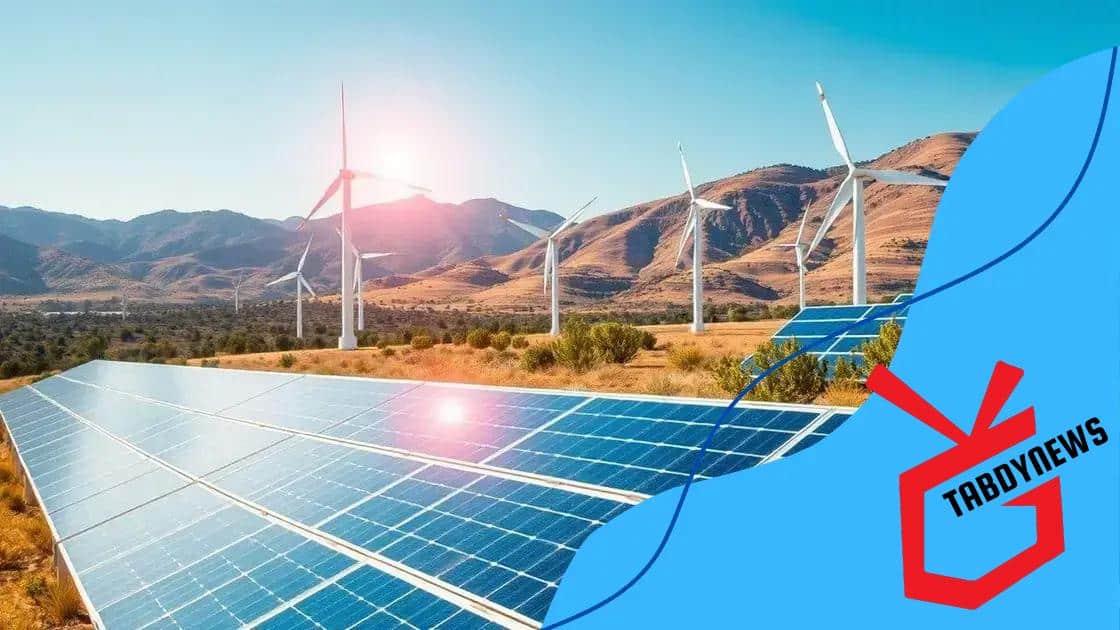Renewable energy subsidy programs: unlock financial benefits

Renewable energy subsidy programs provide essential financial incentives, such as tax credits and rebates, to make renewable energy technologies like solar and wind more affordable and accessible for consumers and businesses.
Renewable energy subsidy programs are increasingly gaining attention as a means to encourage green energy use. Have you considered how these programs might affect your personal finances or contribute to a sustainable future? Let’s delve into why these initiatives matter.
Understanding renewable energy subsidies
Understanding renewable energy subsidies is crucial for anyone interested in sustainable practices. These programs are designed to lower the costs associated with renewable energy, encouraging more people to adopt green technologies.
When we talk about subsidies, we often think about financial assistance. But it’s more than just money. Subsidies can take various forms, including tax credits, rebates, and grants. They aim to make renewable energy sources like solar, wind, and hydroelectric power more accessible.
Types of Renewable Energy Subsidies
Recognizing the types of subsidies can help you determine the best options for your needs. Here are some common forms:
- Tax credits that reduce your overall tax liability.
- Cash rebates provided after the installation of renewable systems.
- Grants awarded for specific renewable energy projects.
- Low-interest loans to finance renewable energy installations.
Each type has its own eligibility requirements. Some may only apply to specific technologies, while others could be available for a broader range of options. This variety means more opportunities for savings.
Eligibility Criteria
To benefit from these programs, understanding the eligibility criteria is essential. Most subsidies require you to meet particular standards. For instance, there might be household income limits or necessary equipment types that qualify.
It’s important to research local and federal programs, as they can differ significantly. For example, some states offer additional benefits that can stack with federal subsidies. This means you could enjoy reduced costs on your renewable energy investment.
As you explore these options, don’t hesitate to consult with experts or government resources. They can provide valuable insights into the specifics of available subsidies and how to apply for them.
Types of subsidy programs available
There are several types of subsidy programs available to support the transition to renewable energy. These programs are designed to encourage adoption and make clean energy solutions more financially accessible for individuals and businesses.
Tax Credits
One of the most popular forms of subsidy is the tax credit. These credits allow you to deduct a percentage of the cost of installing renewable energy systems from your federal tax bill.
- Federal Investment Tax Credit (ITC) for solar panels.
- Production Tax Credit (PTC) for wind energy projects.
- State-level tax credits for various renewable technologies.
Cash Rebates
Many states and utilities offer cash rebates as an incentive for installing renewable energy systems. These rebates can significantly reduce the upfront costs.
Cash rebates can vary based on the technology and the installation size. Often, they are issued after the system is installed, providing a direct financial benefit to homeowners and businesses.
Grants
Grants are another viable option. They provide funding that does not need to be repaid, making them highly attractive.
- Government grants for research and development.
- Grants for community-based renewable energy projects.
- Non-profit organization grants focused on energy efficiency.
Each type of subsidy program has specific requirements and eligibility criteria. Investigating these can unlock valuable resources for potential projects.
Low-Interest Loans
Many programs also offer low-interest loans. These financial products help you finance renewable energy projects with more favorable terms than traditional loans.
Low-interest loans can make it easier to afford major upgrades, such as installing solar panels or upgrading to energy-efficient systems.
Eligibility criteria for subsidies

Understanding the eligibility criteria for subsidies is vital for anyone looking to take advantage of renewable energy programs. Government and utility companies often set specific requirements to ensure that subsidies go to those who genuinely need them.
Generally, eligibility can vary by program and location. It’s essential to research the specific guidelines for the subsidy type you are interested in. For many programs, the following factors will be considered:
Income Levels
Many subsidy programs target low-income households to help them afford renewable energy installations. These programs may require proof of income to qualify.
- Federal income guidelines often determine eligibility.
- Household size can affect maximum allowable income levels.
- Some programs offer tiered benefits based on income.
Property Requirements
Your property must meet certain criteria as well. This may include:
- Being a primary residence, rather than a vacation home.
- Having adequate roof space or land for solar installations.
- Meeting local building codes and regulations.
Additionally, some programs encourage energy efficiency improvements before installing renewable systems. This means that homes may need upgrades, like better insulation, to qualify.
Technology Specifications
For many subsidies, specific technologies must be used. Programs could require that installations comply with certain standards or be certified by recognized organizations.
- Solar panels may need to meet Energy Star ratings.
- Wind turbines must often be certified by the Small Wind Certification Council.
- Systems might need to be installed by licensed professionals.
Researching these criteria ahead of time can save time and frustration when applying for subsidies. By ensuring you meet the requirements, you can maximize your benefits and successfully transition to renewable energy.
How to apply for renewable energy subsidies
Applying for renewable energy subsidies can seem daunting, but understanding the process can make it easier. The steps usually involve gathering information, completing applications, and submitting documents.
The first step in the application process is to research the specific programs available in your area. Different programs might have different requirements or focus on various renewable energy technologies.
Gather Required Documents
Before starting your application, make sure you have all necessary documents at hand. Commonly required documents include:
- Proof of income to meet eligibility requirements.
- Documentation of your current energy usage.
- Details about the renewable energy system you plan to install.
- Photographs or diagrams of your property layout.
Complete the Application
Once you have your documents ready, you can begin filling out the application form. Most applications are straightforward but require accurate information. Double-check your entries to avoid delays.
Many programs allow applications to be submitted online, which speeds up the process. If submitting by mail, ensure everything is sent to the correct address and keep a copy for your records.
Submit Your Application
After completing the application, it’s time to submit it. Be aware of the submission deadlines, as many programs have specific timeframes for applications. Missing a deadline could mean waiting another year to apply.
Upon submission, you may need to respond to additional requests for information or verification. Stay on top of communications from the program to ensure a smooth process.
Follow Up
After submitting your application, follow up if you haven’t received any responses within a reasonable time. Checking in helps keep your application on their radar and can help resolve any issues early.
Impact of subsidies on the renewable energy market
The impact of subsidies on the renewable energy market has been profound and transformative. These financial incentives have not only boosted the adoption of renewable technologies but have also reshaped the entire energy landscape.
Subsidies play a crucial role in lowering the initial costs associated with installing renewable energy systems, such as solar panels and wind turbines. By making these technologies more affordable, subsidies encourage more homeowners and businesses to consider the switch to green energy.
Market Growth
One significant effect of subsidies is the rapid growth of the renewable energy market. As more individuals take advantage of these incentives, the market for solar, wind, and other renewable technologies has expanded significantly.
- Job creation in the renewable energy sector has surged as companies scale up operations to meet growing demand.
- Research and development have been funded to improve technology efficiency and lower costs.
- Competition among industry players has increased, leading to innovation and better services.
Price Stability
Subsidies also lead to greater price stability in the energy market. When renewable energy growth is supported, it helps balance out fluctuations in fossil fuel prices.
With more renewable options available, consumers are less reliant on volatile fossil fuel markets, leading to more predictable energy costs. This stability can encourage further investment in renewable projects.
Environmental Benefits
The environmental impact of subsidies cannot be overstated. By supporting renewable energy, subsidies contribute significantly to reducing greenhouse gas emissions.
- Transitioning to renewables helps decrease air pollution.
- Supporting clean energy reduces the carbon footprint of energy production.
- Greater adoption of renewables speeds up the transition to a sustainable energy future.
Ultimately, subsidies have catalyzed a shift towards a cleaner, more sustainable energy economy, paving the way for future advancements in renewable technologies.
FAQ – Frequently Asked Questions about Renewable Energy Subsidies
What are renewable energy subsidies?
Renewable energy subsidies are financial incentives provided by governments or organizations to promote the adoption of renewable energy technologies like solar and wind.
How do subsidies impact the cost of renewable energy installations?
Subsidies lower the initial costs, making it more affordable for individuals and businesses to install renewable energy systems.
What types of subsidies are available for renewable energy?
Common types of subsidies include tax credits, cash rebates, grants, and low-interest loans that help reduce costs for renewable energy projects.
How can I apply for renewable energy subsidies?
To apply, research available programs, gather required documents, complete the application form, and submit it before the deadline.





